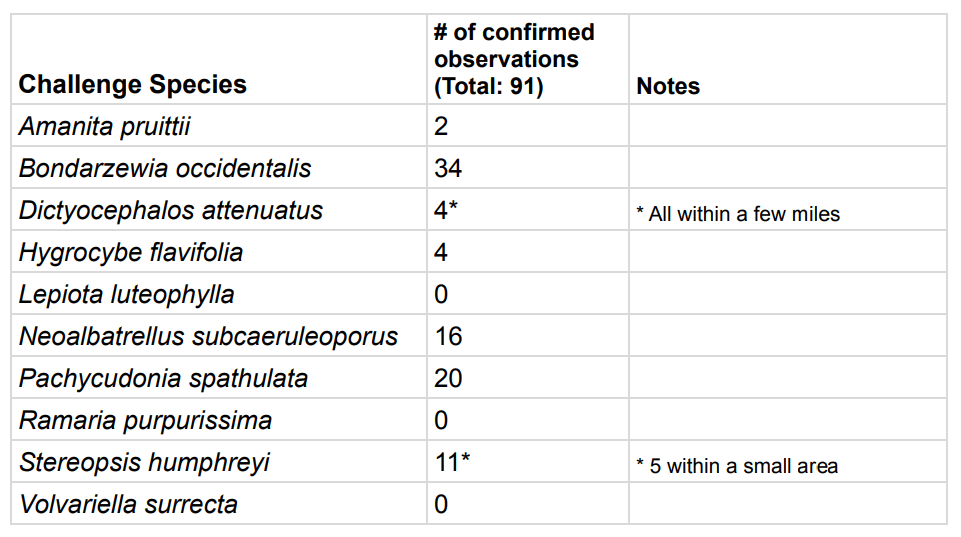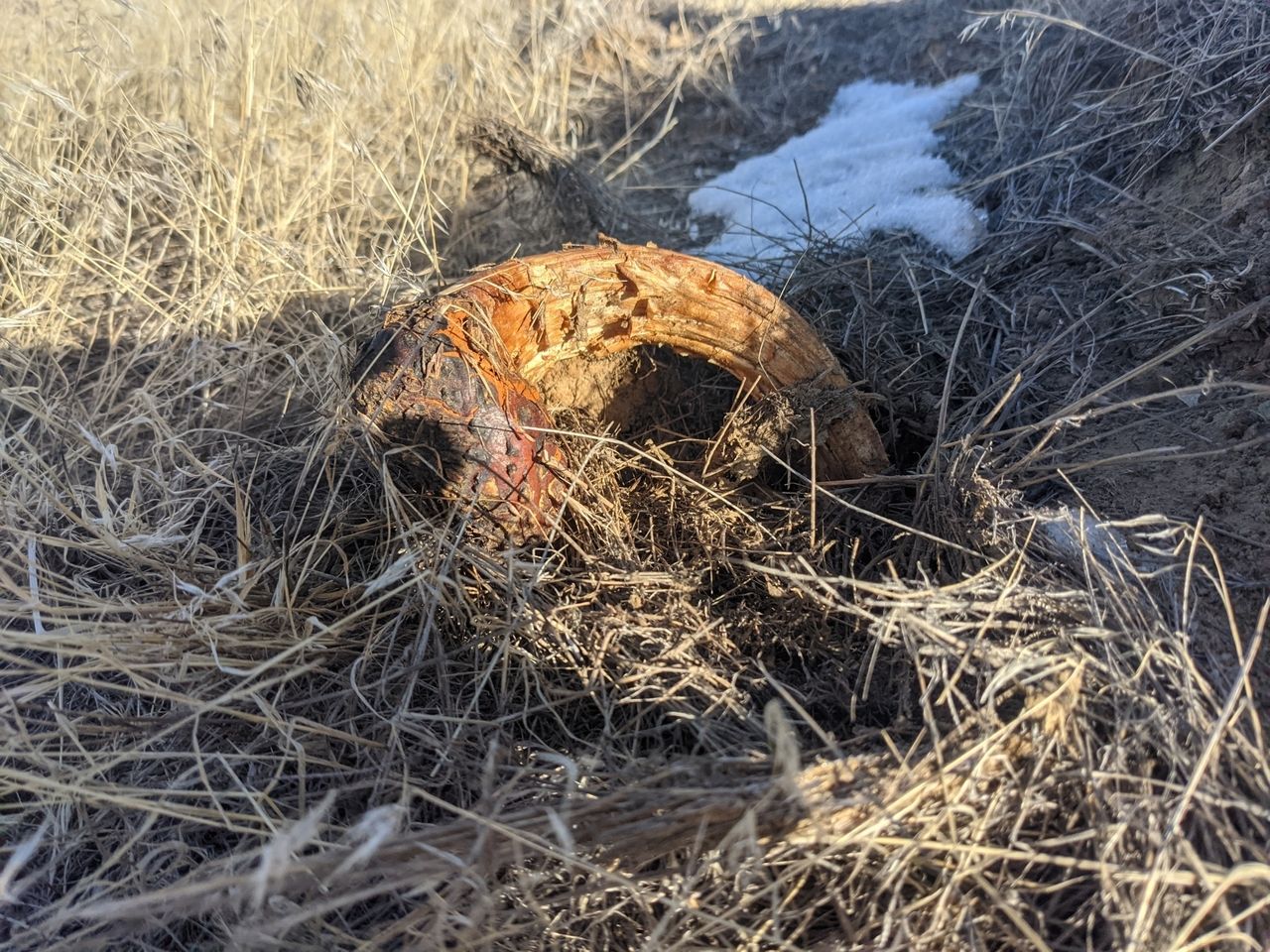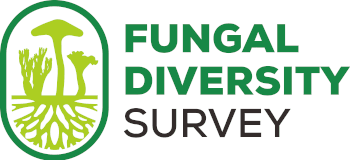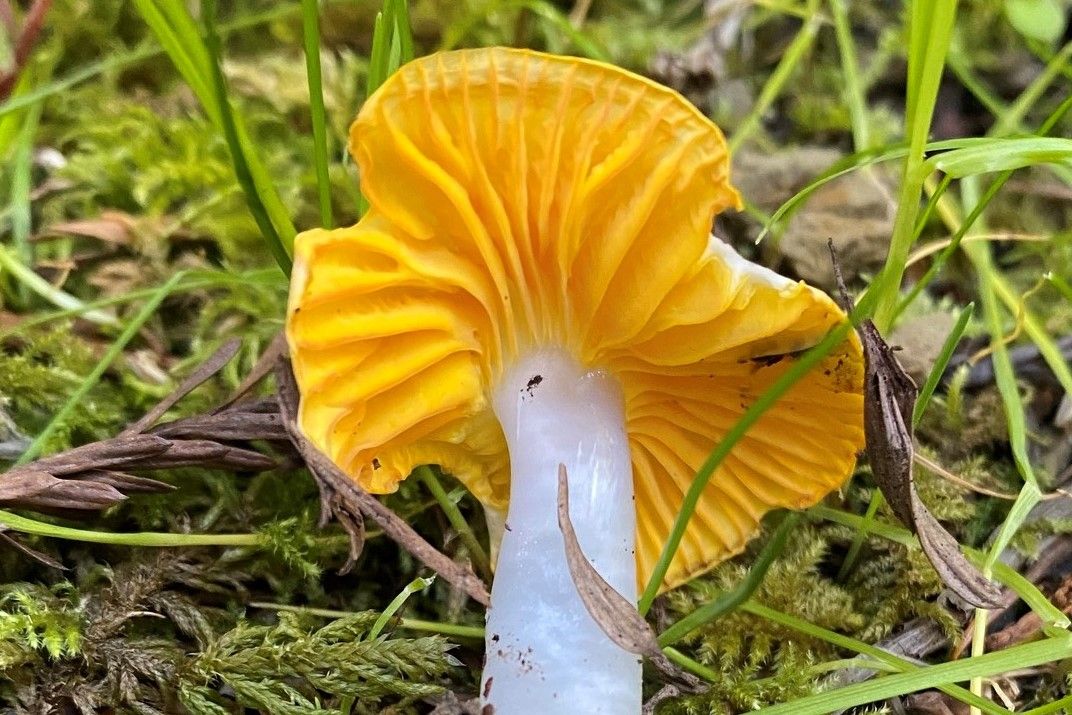The West Coast Rare Fungi Challenge put the spotlight on ten species during its pilot period. Seven out of ten species were observed during the six month pilot period, from October 2020 to the end of March 2021. Knowing that there are thousands of mushroom species on the west coast from Alaska to California, you may wonder, "why were these ten chosen"?
We used a set of criteria that considers the mushroom itself and the habitats we wanted to explore.
The first two criteria have to do with the mushrooms. Number one: are they relatively easy to see, to find, and to identify from a photo? This ruled out tiny mushrooms, and those that appear only underground, such as truffles. Most Mycenas and other more or less brown species fall into this category and did not make the cut.
Number two: are we sure that we have the correct name for this species and is it only one species? We may bend this rule a bit by adding a yet nameless but unique Dendrocollybia to the list in the future, but there are so many species for which it is unclear how they differ from other species and what name is correct. This decision also functioned as a filter that excluded many species.

The ecology and distribution of the species were important factors in consideration -- taking into account its habitat, how often it fruits, and how picky it is in its occurrences
For these criteria we made extensive use of existing databases: Mycoportal.org for data on herbarium collections, MushroomObserver.org and iNaturalist.org for observations, and our own collective mushroom memory and experience.
The species we chose had to be rarely reported or collected, and considered rare in our target area. Many species made this cut, but only some made it further on our list.
Lepiota luteophylla is an example of a species that occurs in only a rare habitat of Monterey cypress groves. Hygrocybe flavifolia, found in redwood forests and bay laurel stands, was also put on the Challenge list and this was not only found in those habitats in California, but also showed up in a mixed forest with Western red cedar and Big-leaf maple in Washington state, far removed from the California locations it was known from.

Species that occur in old-growth forests were favoured above those typical for young woods. Ramaria purpurissima, one of the three that were not found, belongs in this category. Another example, but of a wood inhabiting species, is Bondarzewia occidentalis, probably not rare (yet), but it will be good to have more data on its occurrence, as it favours trees of a certain girth.
We wanted to put some under-visited habitats in the spotlight, so we included Amanita pruittii, an Amanita that does not depend on trees for its sugars and carbs. It is known from occasionally flooded fields and grasslands in Oregon, and was reported from several locations in north-central California.
Another type of unique habitat is formed by madrone and manzanita, here Pachycudonia/Cudonia spathulata grows under the leaf litter. During the Challenge pilot, this species was only found in California, but we suspect that it is more widespread. Stereopsis humphreyi was chosen as one of the few species that is more northern in its distribution -- it grows in small wet dells under Sitka spruce along the coast, from central Oregon northwards into Alaska.

Volvariella surrecta is known from Europe and through North America, but it is very rarely found in the west. This one is easy to identify as it grows only on old fruitbodies of Clitocybe nebularis. It was unfortunately not recorded during the 2020/2021 season, but we hope that this will change in the coming year. The upcoming 2021 FunDiS Northeast Rare Fungi Challenge will also look out for this species.
To balance out our areas of interest, we also wanted to include species from southern California. We chose Dictyocephalos attenuatus, recently found on the Channel Islands. The only finds in 2020 were from a totally different area in Wyoming, more like the Nevada habitat where the species originally was described from. The observations that this Challenge brought forth shows a major range extension for this species and this new location would not have been documented without the Challenge. We will keep our eyes open for this species in the years ahead.
A FunDiS West Coast Rare Challenge observation of Dictyocephalos attenuatus in Shell, WY by Arlan Howe (December 2020). The observations that this Challenge brought forth shows a major range extension for this species. The new location would not have been documented without this Challenge. Link to iNat.

The West Coast Rare Challenge is only beginning, and we considered the pilot to be so successful that we are adding more species to the ongoing Challenge. FunDiS will also be soon unveiling a Northeast Rare Challenge.
One of the new species we are adding to the West Coast Rare Challenge is a little polypore that grows on old sage brush bushes (Artemisia tridentata). The only known records are from one area in southern California, but as sage brush is dominant in huge swathes of land throughout the arid west, it could be much more common than is known now.
Lactarius cordovaensis and Hypocreopsis lichenoides are two of the Challenge’s additional species, the former is only known from one cold location near a glacier close to Cordova, Alaska. Hypocreopsis is in the same category as Volvariella surrecta (one of the three species yet to be found in the Challenge) -- widespread in the northern part of the northern hemisphere, and a parasite on another mushroom, in this case a crust forming Hymenochaete species, but it is rarely reported. One has to crawl through willow scrub to find it!
The list of the original ten species will be expanded to include even more different areas and habitats, and it will be a renewed challenge to find them all in the next mushroom season!
Authors:
Else Vellinga on behalf of the 2020/2021 West Coast Rare Fungi Challenge team: Bitty Roy, Joanne Schwartz, Christin Swearingen, Ken Buegeleisen, Lauren Ré, and Roo Vandegrift.
Featured Image: Hygrocybe flavifolia (Golden-gilled Waxy Cap) by @joshwalker (April 2020). Link to the iNat observation.





